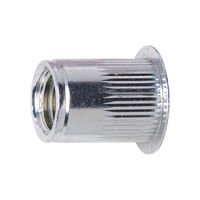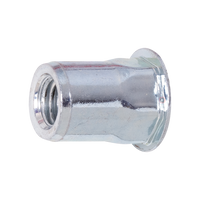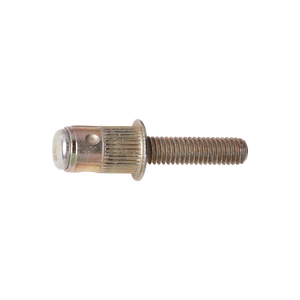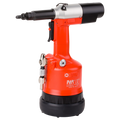What is a rivet nut?
How do rivet nuts work?
Rivet nuts are the ideal threaded insert solution for thin or soft materials. Essentially a rivet nuts is a combination of a nut and a rivet. They install just like a rivet - which makes them great for one side or blind side installations and once installed you have an internal thread that is permanent - like a nut. A tubular fastener that is installed via a rivet nut tool for bolting purposes where conventional tapping is impractical as the material is thin. Ideal for punched or drilled holes that can be installed at any stage of the manufacturing process even after finish coat is applied. Aerobolt has a wide range of sizes including M3, M4, M5, M5, M6, M8, M10, M12 + select imperial sizes in a range of body types that include circular with numerous options, hex shape and threaded stud options.
How do you install a rivet nut?
Installing rivet nuts is a simple process that involves a few steps.
- Step 1. Thread the rivet nut onto the mandrel of the tool, some tools spin themselves to load the rivet nut.
- Step 2. Place the rivet nut into the pre-drilled hole and activate tool to begin swaging process. Tool’s mandrel will pull up rivet nut causing body to collapse & bulge out 360°
- Step 3. The rivet nut has now bulbed & created a lip on the blind side of the material and firmly interlocked itself onto the material.
- Step 4. Rivet nut tool will either automatically or manually reverse out of the rivnut.
Rivnuts or Nutserts? They are all Rivet Nuts.
These are different trademark or registered words that refer to "rivet nut", which is the generic term for these fastening components. Words can be trademarked for brand marketing purposes and sometimes these transcend to everyday language. Popular brand lingo like Nutsert® by Stanley Engineered Fastening, or Rivnut® by Bollhoff are popular trademarks that are used in everyday language to describe the rivet nut fastener.
What are the benefits of rivet nuts?
Rivet nuts provide a quick, reliable, and low-cost system of inserting a thread in thin steel sheeting or tubular material. Rivet nuts offer many benefits over other fasteners such as a nuts & bolt. An innovative invention by BF Goodrich who first used them to mount de-icing boots to aircraft wings in the 1930’s.
7 Key Rivet Nut Benefits.
- One side assembly for fast installations as access to the rear is not required.
- Highly resilient, forming a permanent superior thread for the attachment of a bolt/screw.
- Easy installations with minimal training. Rivnut tools are robust & readily available.
- Can be used to assemble two or more materials, like a rivet.
- Installs into galvanised or pre-painted material without damaging surface.
- Using rivnuts is safer than welding with no harmful vapours, heat or dust.
- Installs into a wide range of material gauges due to its high grip range tolerance.
What are the different type of rivet nuts?
When determining which rivet nut suits your application, consider the body type, there are 3 main body types.
Round Body Rivet Nuts
These are the most popular type of rivnuts, especially the knurled body rivet nuts due to their great resistance to spinning whilst being installed and vibration after installation. Our range of this type of body is called Nutsert xtralok. Predominantly, they have a low-profile wide flange head with the option of open or closed end rivnuts in steel, stainless and aluminium. You will find our rivet nuts are more generous with the material grip range compared to other options in the market.
There are a couple of other round body options, including the smooth body rivnuts, and the slotted shank Plus Nuts or Jack Nuts. The slotted body rivet nuts are ideal in lightweight material like plastics, fiberglass, and composites.
Hexagon Shape Rivet Nuts
Hexagon shaped rivet nuts are designed for use in punched hex shape holes and provide exceptional resistance to spinning (i.e., they cannot be unscrewed). Here at Aerobolt we have two options, and this includes (1) Half Hex (half hex & half round body) and (2) Full Hex shape for extra strength (predominantly hex shape body). We also have open or closed end hex rivnuts in steel or stainless.
Threaded Studs Rivet Nuts
This is a rivnut with a protruding stud (thread) that enables a mating part to be attached to the surface. They are excellent option for a strong load bearing bolt in thin steel sheeting.
After you have selected the body type you will need to determine the correct thread size for your application, and material grip range. Rivnuts sizes are predominantly metric and start from M3 through to M12 with a select range of imperial sizes. Material grip range is the material gauge the rivnut will pull up in, this is critical in ensuring you have selected the right fastener. These two factors are essential in ensuring you have made the correct selection. Also review material type, head style, and torque to turn resistance.
SELECTING THE RIGHT TOOL FOR RIVET NUTS
After you have selected the correct rivet nut to suit your application, you will need to consider tools. There are 3 main options & we at Aerobolt term them nutsert or rivnut tools and they include air, cordless or manual.
Air rivnut tools: For frequent rivnut installation, pneumatic (air-powered) is the easy choice. Air rivnut tools offer fast installations with consistent results. Some of the pros include: Easy to use—the tool spins the mandrel to thread the rivnut, then retracts to collapse the body of the rivnut with little physical exertion required. The tool will pull to either a set pressure or a set stroke. Cons: Require an air source such as a compressor, possibly limiting mobility and making remote use impractical.
Manual rivnut tools: For the occasional installation of rivnuts, manual tools are your most cost-effective option. They work by adding the rivnut to the end of the tool, squeezing/torquing, and retracting the tool from the now applied rivnut. Some of the pros include: Inexpensive, easy concept, great for the handy person. Cons: They require physical force to use.
Cordless battery rivnut tools: Cordless rivnut tools run on battery power and provide incredible versatility, hence allowing you to install rivnuts from practically anywhere. Like pneumatic tools, battery-powered tools are basically point-and-shoot. Pros: Mobility, speed. Cons: Batteries have limited charge before needing to be plugged in again, cost.
101 RIVET NUT APPLICATIONS
Rivet nuts have 1001 uses which make them suitable for various applications such as; automotive manufacturing, aviation, balustrades, commercial kitchens, commercial furniture & fit-outs, electrical appliances & switchboards, Emergency vehicles, Farming equipment, HVAC (Heating, ventilation & air conditioning), medical equipment, military equipment & vehicles, Playground equipment, sheet metal fabrication, solar installations, refrigeration, RV Vehicles, Trucks & Trailers, Ute canopy bodies, Utility vehicles and so much more.
In summary rivet nuts are fundamentally an expanding nut that attaches onto a steel sheet surface for bolting purposes, where a simple hole opening is not possible because the material is too thin to hold a bolt or a screw. Ideal for punched or drilled holes, they can be installed at any stage of the production, even after finish coat is applied. Rivet nuts are They are an easy solution that requires an easy to use rivnut or rivet nut tool.






